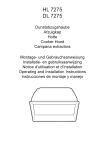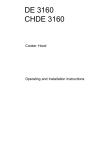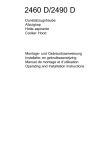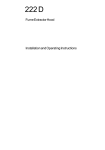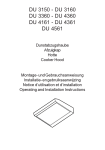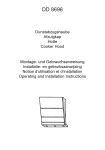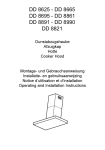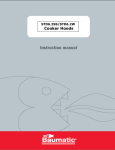Download AEG 2460 D Specifications
Transcript
2460 D Cooker hood Operating and Installation Instructions Printed on recycled paper AEG - putting words into action 2 Contents Safety warnings For the User For the Installer 4 4 4 Description of the Appliance Extractor version Filter Version 6 6 6 Control Panel 7 Maintenance and care Cleaning the hood Metal grease filter Removing the metal grease filter Charcoal filter Changing the light bulb 8 8 8 8 10 11 What to do if 12 Service and Spare Parts 13 Guarantee Conditions 14 Technical Specifications Mounting accessories included 16 16 Electrical connection Safety warnings for the electrician Wall unit mounting 17 17 18 3 Safety warnings For the User • The cooker hood is designed to extract unpleasant odours from the kitchen, it will not extract steam. • Always cover lighted elements, to prevent excess heat from damaging the appliance. In the case of oil, gas and coal fired cookers it is essential to avoid open flames. • Also, when frying, keep the deep frying pan on the cooker top/cooker under careful control. • The hot oil in the frying pan might ignite due to overheating. • The risk of self-ignition increases when the oil being used is dirty. • It is extremely important to note that overheating can cause a fire. • Never carry out any flambé cooking under the hood. • Always disconnect the unit from the power supply before carrying out any work on the hood, including replacing the light bulb (take the cartridge fuse out of the fuse holder or switch off the automatic circuit breaker). • It is very important to clean the hood and replace the filter at the recommended intervals. Failure to do so could cause grease deposits to build up, resulting in a fire hazard. For the Installer • When used as an extractor unit, the hood must be fitted with a 150mm diameter hose. • Should there already be a pipe of diameter 125 mm that ducts to the outside through the walls or roof, it is possible to use the 150/ 125 mm reduction flange provided. In this case the hood will be slightly more noisy. • When installing the hood, make sure you respect the following minimum distance from the top edge of the cooking hob/ring surfaces: electric cookers 500 mm gas cookers 650 mm coal and oil cookers 700 mm min. • The national standard on fuel-burning systems specifies a maximum depression of 0.04 bar in such rooms. • The air outlet must not be connected to chimney flues or combustion gas ducts. The air outlet must under no circumstances be connected to ventilation ducts for rooms in which fuel-burning appliances are installed. 4 • It is advisable to apply for authorization from the relevant controlling authority when connecting the outlet to an unused chimney flue or combustion gas duct. The air outlet installation must comply with the regulations laid down by the relevant authorities. • When the unit is used in its extractor version, a sufficiently large ventilation hole must be provided, with dimensions that are approximately the same as the outlet hole. • National and regional building regulations impose a number of restrictions on using hoods and fuel-burning appliances connected to a chimney, such as coal or oil room-heaters and gas fires, in the same room. • Hoods can only be used safely with appliances connected to a chimney if the room and/or flat (air/environment combination) is ventilated from outside using a suitable ventilation hole approximately 500-600 cm2 large to avoid the possibility of a depression being created during operation of the hood. • If you have any doubts, contact the relevant controlling authority or building inspector’s office. • Since the rule for rooms with fuel burning appliances is “outlet hole of the same size as the ventilation hole”, a hole of 500-600 cm2, which is to say a larger hole, could reduce the performance of the extractor hood. • If the hood is used in its filtering function, it will operate simply and safely in the above conditions without the need for any of the aforementioned measures. • When the hood is used in its extractor function, the following rules must be followed to obtain optimal operation: — short and straight outlet hose — keep bends in outlet hose to a minimum — never install the hoses with an acute angle, they must always follow a gentle curve only — keep the hose as large as possible (preferably the same diameter as the outlet hole). • Failure to observe these basic instructions will drastically reduce the performance and increase the noise levels of the extractor hood. 5 Description of the Appliance • The hood is supplied as an extractor unit and can also be used with a filtering function by fitting one charcoal filter • You will need an original AEG charcoal filter for this function (Available from your local AEG Service Force Centre). Extractor version • The air is discharged to the outside through a hose, which must be fitted to connection flange A. Fig. 1. • In order to obtain the best performance the hose should have a diameter equal A to the outlet hole. Should there already be a pipe of diameter 125 mm that ducts to the outside through the walls or roof, it is possible to use the 150/125 mm reduction flange provided. In this case the hood will be slightly more noisy. Fig. 1 Filter Version • The air is filtered through a charcoal filter and returned to the kitchen through the top grill of the outlet pipe. • You will need an original AEG charcoal filter for the filtering function. • Fix the deflector using 4 screws Ø 3,5x6.5 mm. Fig. 2. • Optionally, the position of the chimney elements can be changed. When using the hood in the filter version the chimney must be fixed at the top, with the air outlet grill at the side. Fig. 2 6 Control Panel • Best results are obtained by using a low speed for normal conditions and a high speed when odours are more concentrated. Turn the hood on a few minutes before you start cooking, you will then get an under pressure in the kitchen. The hood should be left on after cooking for about 15 minutes or until all the odours have disappeared. abcde- Indicator lamp Light ON/OFF switch Motor OFF - Speed 1 push-button Speed 2 push-button Speed 3 push-button Correct ventilation If the cooker hood is to work correctly there must be an under pressure in the kitchen. It is important to keep the kitchen windows closed and have a window in an adjacent room open. Important This is not applicable for recirculation. Great care must be taken if the hood is used at the same time as a burner or fireplace (e.g. gas, diesel, coal or wood heaters, water heaters, etc.), as the hood will expel air which is required by these other appliances. In this situation, ensure that a window is open. The negative pressure in the room must not exceed 0,04 mbar to prevent fumes being drawn back into the room by the cooker hood. 7 Maintenance and care • The hood must always be disconnected from the electricity supply before beginning any maintenance work. Cleaning the hood • Clean the outside of the hood using a damp cloth and a mild detergent. • Never use corrosive, abrasive or flammable cleaning products. • Never insert pointed objects in the motor’s protective grid. • Only ever clean the switch panel and filter grille using a damp cloth and mild detergents. • It is extremely important to clean the unit and change the filters at the recommended intervals. Failure to do so will cause grease deposits to build up that could constitute a fire hazard. Metal grease filter • The purpose of the grease filters is to absorb grease particles which form during cooking and it must always be used, either in the external ducted or internal recycling function. Attention: the metal grease filters must be removed and washed, either by hand or in the dishwasher, every four weeks. Open the metal grease filter • First, push the metal grease filter stop backwards, then extract the filter, pulling downwards. Fig. 3. Fig. 3 Hand washing Soak grease filters for about one hour in hot water with a greaseloosening cleaner, then rinse off thoroughly with hot water. Repeat the process if necessary. Refit the grease filters when they are dry. 8 Dishwasher Place grease filters in dishwasher. Select the most powerful washing programme and highest temperature, at least 65°C. Repeat the process. Refit the grease filters when they are dry. When washing the metal grease filter in the dishwasher a slight discolouration of the filter can occur, this does not have any impact on its performance. 9 Charcoal filter • The charcoal filter should only be used if you want to use the hood in its filtering function. • To do this you will need an original AEG charcoal filter. • Replacing the charcoal filter The charcoal filters cannot be cleaned, we recommend that they should be replaced approximately every three months or more often if the hood is used for more than three hours per day. • Fitting Remove the frame b which supports the filter c by unscrewing it from the hood a, Fig. 4. Insert the coal mattress inside the frame and put all parts back in their place. • To remove proceed in the reverse order. • Always specify the hood model code number and serial number when ordering replacement filters. This information is shown on the registration plate located on the inside of the unit. • The charcoal filter can be ordered from your local AEG Service Force Centre. Fig. 4 10 Warning • Failure to observe the instructions on cleaning the unit and changing the filters could cause a fire hazard. You are therefore strongly recommended to follow these instructions. • The manufacturer declines all responsibility for any damage to the motor or any fire damage linked to inappropriate maintenance or failure to observe the above safety recommendations. Changing the light bulb • • • • • Disconnect the cooker hood from the mains supply. Remove the lamp cover, use a screw driver as a lever. Fig. 5. Replace the old bulb with a new one of the same type. Refit the lamp cover. If the light does not come on, make sure the bulb has been inserted in correctly before contacting your local AEG Service Force Centre. Fig. 5 11 What to do if If your appliance fails to work properly please carry out the following checks. Symptom Solution The cooker hood will not start... Check that: The hood is connected to the electricity supply. Check that the fan speed control is set to 1, 2 or 3. The cooker hood is not working effectively.. . Check that: The fan speed is set high enough for the task. The grease filters are clean. The kitchen is adequately vented to allow the entry of fresh air. If set up for recirculation, check that the charcoal filter is still effective. If set up for extraction, check that the ducting and outlets are not blocked. The cooker hood has switched off during operation... The safety cut-out device has been tripped. Turn off the hob and then wait for the device to reset. If the hood has been installed below the heights indicated in the installation instructions the motor will cut-out frequently which will damage the hood. If after all these checks, the problem persists, contact your local Service Force Centre, quoting the model and serial number. Please note that it will be necessary to provide proof of purchase for any in-guarantee service calls. In-guarantee customers should ensure that the above checks have been made as the engineer will make a charge if the fault is not a mechanical or electrical breakdown. 12 Service and spare parts In the event of your appliance requiring service, or if you wish to purchase spare parts, contact your local AEG Service Force Centre by telephoning 08705 929 929 Your call will be automatically routed to the Service Centre covering your post code area. For the address of your local Service Force Centre and further information about Service Force, please visit the website at www.serviceforce.co.uk Please ensure that you have read the section „What to do if....“ as the engineer will make a charge if the fault is not a mechanical or electrical breakdown even the appliance is under warranty. Please note that proof of purchase is required for in-guarantee service calls. Help us to help you Please determine your type of enquiry before writing or telephoning. When you contact us we need to know: • Your name • Address and post code • Telephone number • Clear and concise details of the fault • Name and model of the appliance* • E number* * This information can be found on the rating plate, which can be seen when the grease filters are removed. Customer Care For general enquiries concerning your AEG appliances, or for further information on AEG products, please contact our Customer Care Department at the address below or visit our website at www.aeg.co.uk Customer Care Department AEG Domestic Appliances 55-77 High Street Slough Berkshire SL1 1DZ Tel.: 08705 350 350* * calls to this number may be recorded for training purposes. 13 Guarantee conditions AEG offer the following guarantee to the first purchaser of this appliance. 1. The guarantee is valid for 12 months commencing when the appliance is handed over to the first retail purchaser, which must be verified by purchase invoice or similar documentation. The guarantee does not cover commercial use. 2. The guarantee covers all parts or components which fail due to faulty workmanship or faulty materials. The guarantee does not cover appliances where defects or poor performance are due to misuse, accidental damage, neglect, faulty installation, unauthorised modification or attempted repair, commercial use or failure to observe requirements and recommendations set out in the instruction book. This guarantee does not cover such parts as light bulbs, removable glassware or plastic. 3. Should guarantee repairs be necessary the purchaser must inform the nearest customer service office (manufacturer`s service or authorised agent). AEG reserves the right to stipulate the place of the repair (i.e. the customer`s home, place of installation or AEG workshop). 4. The guarantee or free replacement includes both labour and materials. 5. Repairs carried out under guarantee do not extend the guarantee period for the appliance. Parts removed during guarantee repairs become the property of AEG. 6. The purchaser`s statutory rights are not affected by this guarantee. European Guarantee If you should move to another country within Europe then your guarantee moves with you to your new home subject to the following qualifications: - The guarantee starts from the date you first purchased your product. - The guarantee is for the same period and to the same extent for labour and parts as exist in the new country of use for this brand or range of products. - This guarantee relates to you an cannot be transferred to another user. - Your new home is within the European Community (EC) or European Free Trade Area. - The product is installed and used in accordance with our instructions and is only used domestically, i.e. a normal household. - The product is installed taking into account regulations in your new country. 14 Before you move please contact your nearest Customer Care Centre, listed below, to give them details of your new home. They will then ensure that the local Service Organisation is aware of your move and able to look after you and your appliances. France Senlis +33 (0) 44 62 29 29 Germany Nürnberg +49 (0) 800 234 7378 Italy Pordenone +39 (0) 800 117 511 Sweden Stockholm +46 (0) 8 672 5360 UK Slough +44 (0) 1753 219899 15 Technical Specifications Models Dimensions - extractor version (in cm): Height Width Depth 2460 D 68-113 59,8 45 Dimensions - filter version (in cm): Height 67,5-122,5 Width 59,8 Depth 45 Maximum absorbed power: 195 W Motor absorption: Lighting: 1 x 155 W 2 x 20W Length of the cable: 150 cm Mounting accessories included 6 wall plugs Ø 8 mm 6 wood-screws 5 x 45 mm 6 metal screws 2,9 x 6,5 8 metal screws 3 x 10 1 deflector 1 chimney support 1 reduction flange Ø 125-120 mm 1 support bracket 16 Electrical connection Safety warnings for the electrician The electric outlet should be placed inside the chimney.The hood has a power cable, 150 cm, with earth connection and the rated voltage is 220 - 240 V. Connect the hood to the mains supply via a double pole switch which has 3 mm minimum separation between the contacts. This switch must be accessible at all times. The following is valid in the United Kingdom only: - the wire which is coloured green and yellow must be connected to the terminal which is marked with the letter E or by the earth symbol ), or coloured green or green and yellow; ( - the wire which is coloured blue must be connected to the terminal which is marked with the letter N or coloured black, - the wire which is coloured brown must be connected to the terminal which is marked with the letter L or coloured red. 17 Wall unit mounting - Fig. 6 • Only for extractor version: position the upper section of the chimney so that the oulet slots H are not visible (see also A-B-C sequence on on Fig. 6). • Fix each other both parts of the hood (1), make all connections between the two parts (2) and fix with 6 screws (3). • Mark the wall with a centre line, this will aid mounting (4), position the template so that the mid line printed on the template matches with the center line previously drawn, the lower side of the template corresponds to the lower side of the hood once mounted (5). • Drill two holes Ø 8mm and fix the support bracket with two wall plugs and screws (6). Hang the hood (7) and adjust its position (8-9). • From the inside of the hood mark two points for final fixing (10). • Remove the hood (11) and drill two holes Ø 8mm (12), fit two wall plugs (13). • Rest the chimney support bracket G against the wall, touching the ceiling. Use the support bracket as a drilling template and mark 2 holes with a pencil (14), dril the holes insert 2 wall plugs, fix the chimney support bracket to the wall using two screws (15) (If the hood is to be used in filter version, fix deflector F to the chimney support bracket G using 4 screws). • Hang the hood again (16) and fix it with two screws (17). • Connect an exhaust pipe to the outlet hole of the hood B (18) for direct discharge of fumes to the outside (Extractor version) or to be connected to the connection ring located on the bottom of the deflector F (Filter version). • Make the electrical connections (19). • Fit the chimney sections and fix them at the top to the chimney support G (20b) using 2 screws (20a), slide the bottom section of the chimney down until it completely covers the suction unit and slots into the housing provided on top of the hood (21) and fix with 2 screws. 18 A-B-C, Extractor version only! 20a 4 20a H G 14 14 20b 15 20b F 7-16 1 7-16 11 21 11 18 19 6 1 1 B 98 5 9 8 9 8 13 12 12 10 2 10 13 17 1 1 3 3 17 3 22 22 NOTE: 18 not supplied 3 Fig. 6 19 AEG Hausgeräte GmbH Postfach 1036 D-90327 Nürnberg http://www.aeg.hausgeraete.de © Copyright by AEG LI1UGB Ed. 04/02






















